
30 minute read
Lifestyles
one of the largest Mars vehicles yet. square feet, the Curiosity rover is pounds and taking up an area of 9 Weighing in at around 2,000 personal point of view. NIC to follow the event from a more if this is a valuable opportunity for dents, Stephens said, so she feels as Only two other attendees are stu- from the White House.” cists, librarians… even two people Stephens said. “There are astrophysi- “The 150 people are so random,” sions. eral astronauts from previous mis- share Thanksgiving dinner with sev- Stephens has the opportunity to more than just Tweeting the event. are invited to be involved in much dates for the Tweetup, but attendees November 23 and 25 are the set ing ‘We’re still here!’” Stephens said. “I guess this is NASA’s way of say- anticipated launch. Tweet with NASA during this much- will have the opportunity to tour and Florida. A myriad of different people Cape Canaveral Air Force Station in ed Launch Alliance Atlas V 541 from experiences at the launch of the Unit- Twitter followers to share their own a launch-day Tweetup, inviting 150 This year, NASA has arranged for ity rover, destination Mars. the Nov. 23 launch of the new Curios- hope that she would be able to attend followed NASA’s Twitter page in nursing at NIC. By night, Stephens By day, Christie Stephens studied







Staff Contributor Sarah Munds
“I guess I’m most excited about study and analysis. ing Martian rocks back to Earth for of precision is a step toward bring- ing sites. Most importantly, this level five times smaller than previous land- miles long in the Gale Crater, about land on a target area of only twelve as well. This mission, Curiosity will improved from previous missions 2012. Landing of the rover has been al on Mars is scheduled for August of Curiosity’s estimated time of arriv- every tech item I have!” era,” Stephens said. “I’m bringing your phones and parts of your cam- we use every day, like the screens on exciting this is. NASA built the stuff “I want people to see just how ed Department of Energy. even teamed up with the United Stat- the rover’s energy supply, NASA has Martian year or 687 Earth days. For surface of the red planet for an entire Curiosity is planned to traverse the plutonium-283’s radioactive decay, feet a day. Powered by the heat from two feet high and traveling up to 700 over obstacles up to approximately cover more diverse terrain; climbing riosity has also been engineered to pieces of equipment on board. Cu- X-Ray Spectrometer are other star ment Detector, and Alpha Particle A ChemCam, Radiation Assess- said. even Twitter capabilities, Stephens in general, with an on-board lab and is also one of NASA’s largest rovers bial life on the red planet. This rover will explore the possibilities of micro- two-year mission to Mars, the rover During the Curiosity’s









sia’s Soyuz TMA-22 team. can astronaut into space with Rus- nounced its plans to send an Ameri- up with Russia, and has recently an- time, the United States has teamed ation,” Stephens added. In the mean- shuttle has become “too old for oper- Canaveral, as the current space sioned to build a new shuttle at Cape either. Boeing has been commis- ing American astronauts into space, price tag. NASA hasn’t ceased send- riosity rover heralds a $2.5 billion The launching of the Mars Cu- mission to Mars. compromising the purpose of this violates international law along with ing microbes from Earth into space going into outer space. Introduc- techniques used to sterilize crafts tor, wrote her thesis on the aseptic Fruth, microbiology lab instruc- upcoming launch, either. Dr. Ingrid filiate who has been involved in the Stephens isn’t the only NIC af- expertise behind the launch. nerds” can go and learn about the ratory’s web page, where “science to check out the Jet Propulsion Labo- also encourages interested students osity itself @MarsCuriosity. Stephens can even follow the tweets from Curi- phens30, but NASA’s as well. One not only her page, twitter.com/cste- phens invites NIC students to follow of the Kennedy Space Center. Ste- behind the launch as well as a tour with the engineers and scientists attendees, will get one-on-one time Stephens, along with the 149 other Stephens. that actually made the rover,” said meeting the scientist and engineers
the plunge through the upper the plunge through the upper the heat generated during the heat generated during tem (enclosed inside) from tem (enclosed inside) from components of the flight sys- components of the flight sys- The aeroshell protects other The aeroshell protects other atmosphere to decelerate. atmosphere to decelerate. uses friction with the Martian uses friction with the Martian cruise stage, the aeroshell cruise stage, the aeroshell . After jettisoning the After jettisoning the



from Earth to Mars. from Earth to Mars. maneuvering during the trip maneuvering during the trip that has provided power and that has provided power and tached to the cruise stage tached to the cruise stage aeroshell capsule is still at- aeroshell capsule is still at- at upper left, where the at upper left, where the . The series begins

launch.lized for the Mars Curiosity lized for the Mars Curiosity similar process will be uti- similar process will be uti- finished design, although a finished design, although a preliminary concepts, not a preliminary concepts, not a 2020. This illustration depicts 2020. This illustration depicts and bring them to Earth after and bring them to Earth after samples of Martian rocks samples of Martian rocks als for a mission to gather als for a mission to gather are collaborating on propos- are collaborating on propos- European Space Agency European Space Agency ing on Mars. NASA and the ing on Mars. NASA and the F) in the spacecraft’s land- F) in the spacecraft’s land- ries of six steps (A through ries of six steps (A through return mission portrays a se- return mission portrays a se- Mars sample of a proposed ist’s concept This art-
rover would deliver previousrover would deliver previousAfter the landing, the After the landing, the way. way. descent stage flies out of the descent stage flies out of the ing cords are severed and the ing cords are severed and the -- touches down, the connect-- touches down, the connectrover and an ascent vehicle rover and an ascent vehicle The lander -- bearing a The lander -- bearing a
Caltechsponing labels: NASA/JPL- A-F infograph and correNASA/JPL-Caltech Background image: tributions: Image and information at- altitude and velocity. altitude and velocity. input about the spacecraft’s input about the spacecraft’s proach is based on radar proach is based on radar steps during this final ap- steps during this final ap- a bridle. Timing of crucial a bridle. Timing of crucial gins lowering the lander on gins lowering the lander on . The descent stage be The descent stage be

the ground. the ground. of the final approach toward of the final approach toward stage fire to control the speed stage fire to control the speed retro rockets on the descent retro rockets on the descent the parachute and aeroshell, the parachute and aeroshell, After separation from the descent. the descent. chute further slows chute further slows spacecraft’s para- spacecraft’s para- portrayed, the portrayed, the third step third step . In the In the
ter.com/MarsCuriosity.ings of the Rover itself at twit-phens30 and also the twittertwitter at twitter.com/csteFollow Christie Stephens’ Earth. Earth. would take the samples to would take the samples to orbit with a spacecraft that orbit with a spacecraft that Mars for a rendezvous in Mars for a rendezvous in samples off the surface of samples off the surface of which would then lift the which would then lift the ples to the ascent vehicle, ples to the ascent vehicle, cached sam- cached sam- ly ly sphere. sphere. atmo- atmo-



Paqman_@yahoo.com -- Contact Michael Paquin Lifestyles tip? Story idea?
W W W . N I C S E N T I N E L . C O M
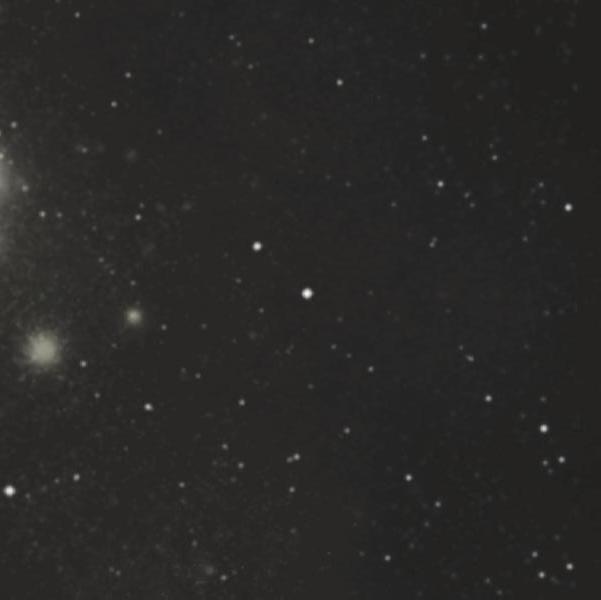




Lifestyles
MONDAY, NOVEMBER 14, 2011





The lowdown on laundry lamentations
The cost of doing laundry at NIC takes me to the cleaners
Jake Wright Martin
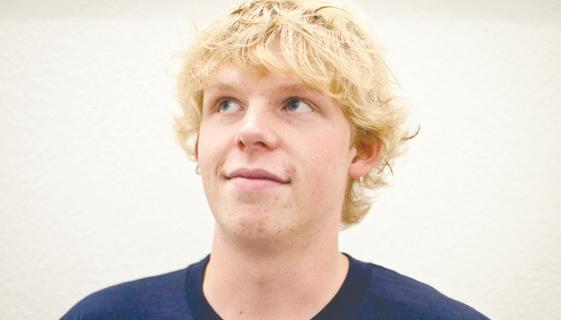

Staff Contributor
Why the hell does laundry cost so much? We already pay several thousand dollars to live here. Are tokens for the machines to much to ask? We’re all broke, no need to kick a dead dog if you know what I mean. It doesn’t look like much if you’ve never done your laundry in the dorm laundry room. Let’s do the math shall we. One load in the washer costs $1.25, $1.50 if you want the “super cycle” and then another 25 cents for every ten minutes in the dryer. The dryers are pretty big so you can usually put all your clothes in one, however the washers are small and the average laundry basket takes about two loads to finish. So right there you’re looking at $2.50 then you have to remember the drying time. One full load in the dryer takes about an hour and a half to dry all the way. That’s about another $2.25 which puts you right around $4.75 if you did the super cycle it would be $5.25. Put in prospective one semester of laundry, at two
“It is the opinion of loads washed one dried, every week. This my peers comes out to that they could somewhere in the general vicinity of $85.50. simply have washer/ Just for your laundry! I share the belief with dryer many of my feltokens.” low NIC dorm residents that this is ridiculous. Unless you have access to outside forms of cheaper laundry doing you are stuck paying an extra $ 85 a semester to live in the dorms. I think that if you pay to live on campus, and you pay to attend school at NIC then they should at least give us a brake on our laundry. Maybe this is selfish, but like I said before, we’re all broke. In retrospect, at least the dorm is equipped with working and decent quality washers and dryers. And I will admit that the convenience is at least worth part of the price we pay. I suppose if you could figure out what it would cost to take your laundry to a laundry mat in town. Just think about it, even the cost of driving home or to a friend’s house to clean your clothes could cost quite a bit more. At least, one could put a regular change machine in the laundry room. Honestly, digging up enough change to run the washers is usually more difficult than forking over the extra five bucks. You can’t even change your dollars for cents at the office in the foyer. When in need of coins and its after say, eight o’clock, there isn’t anywhere to get change unless you walk the four or so blocks up to the gas station on Northwest Blvd. It is the opinion of my peers that they could simply have washer/dryer tokens. And if you didn’t have tokens, you could go to the laundry room and change your money for tokens by way of a token machine. I give credit to one of my roommates for the token idea. I will not take credit for that which is not mine, but I will promote a good idea, which it is. I believe there is also a system in some colleges that allow you to swipe your meal card at the vending machines. Could it be possible to do the same thing with the washers and dryers? It would be much less of a hassle to figure out change or tokens if you could just swipe your card. People might have to make adjustments for how much they’re spending so as they still have enough for food. Still it would be nicer than trying to cough up the change.
Learning lessons through heritage Speaker relates personal journey through understanding her ancestors
Kaye Thornborugh
Staff Contributor
Robbie Paul’s journey began on the night she almost took her own life. Six months before, her husband left her. Paul, an enrolled Nez Perce tribal member, said she “was going to be that tough Indian woman and not feel.” She fell into a deep depression, refusing to acknowledge her feelings—but her buried emotions came out one night when Paul was on the phone with her daughter. “I didn’t want to be here. I was on a downward spiral,” Paul said. “My daughter was really concerned, and I hung up on her.” Then she took another pill. It was then, Paul said, that she heard a voice: “Answer the phone,” it said, and when Paul picked up the receiver, her counselor was on the other end. The conversation with Paul’s counselor kept her from taking her life, she said—and it was the voice of her ancestors that urged her to have it. “This is where I began to understand that we have to listen to our ancestors,” Paul said. “That was the night of beginning to look differently.” Since then, Paul has earned a PhD in psychiatry and is now the Director of Native American Health Sciences at Washington State University. For years, she has also been on a personal journey to understand herself, her family and the Nez Perce people through the concept of historical trauma. Paul spoke about this journey at NIC Oct. 26. First identified by Maria Yellow Horse Brave Heart, historical trauma is “promi
Sarah Tousley
Staff Contributor Anthony Pennazoli, 50, is a man with a positive outlook and who says “It’s up to you to keep the faith.” He came to NIC in order to take microbiology which was needed to join the nursing program. He was keeping up his good grades and had everything under
Carrie Rishsew
Staff Contributor On Oct. 29 Phi Theta Kappa met for an orientation/game night. The club played ping pong and laughed together as they bonded. In attendance were the president of the club, Patty Murk and the vice president, Eric Pezley along with several other members; both new and old. Eric Rivera, the service coordinator of the group, was also in attendance. Rivera helps the club to organize projects, both community and club related. “I worked the Commit to Complete (C4) table when we were gathering signatures and mostly just do what the president and vice president need to have done,” Rivera said. In order to join this organization, a student must be enrolled in a regionally accredited college that offers an associate’s degree, maintain at least a 3.5 GPA, and complete at least 12 hours of coursework that may be applied to an associate degree. Also, an eligible student must be invited in order to join. It is also a requirement for members to follow the moral standards as
Paul finds solace from understanding plights of her ancestors. Ethan Schlussler/Sentinel
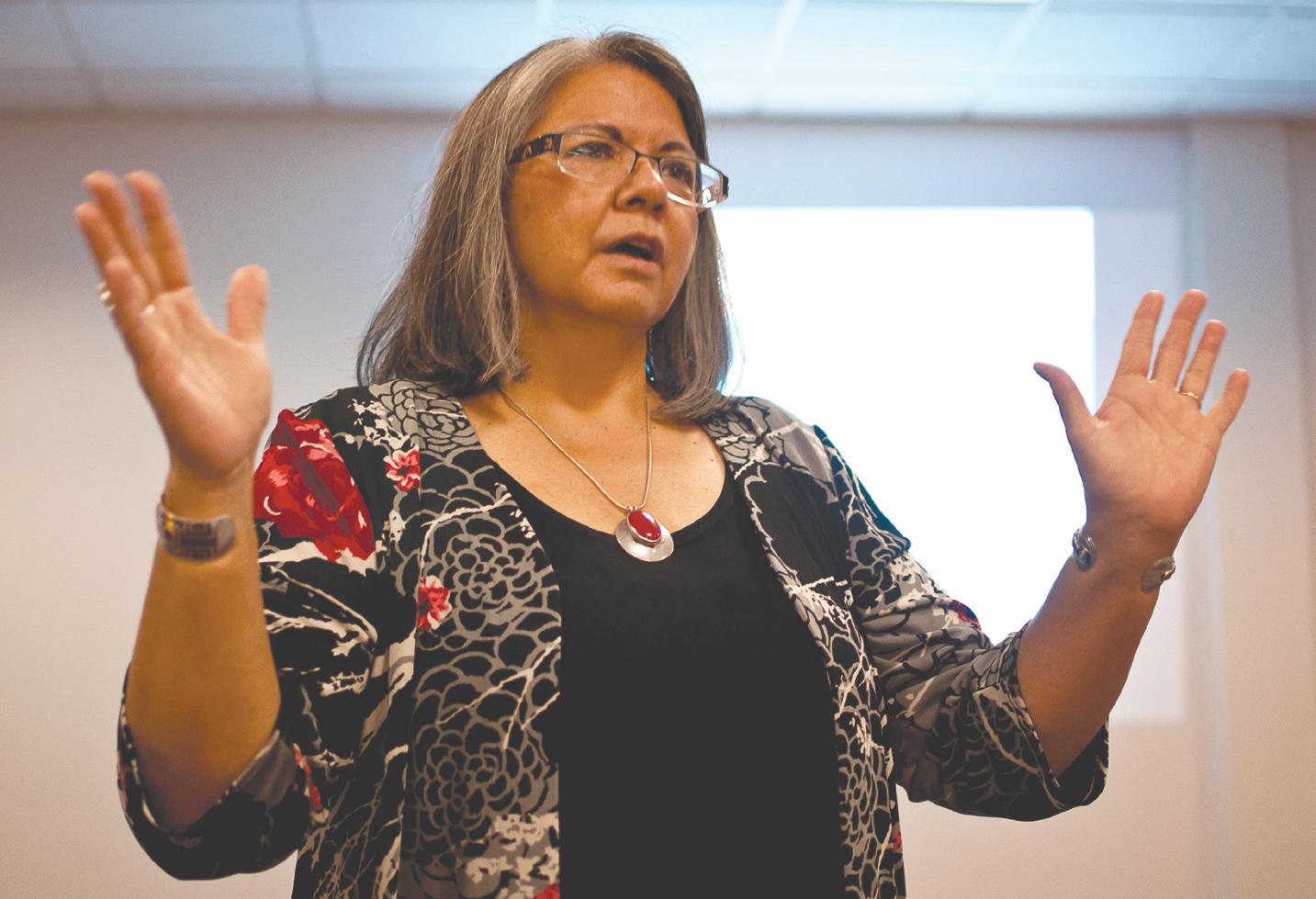
nent, significant, unsettled bereavement” resulting from “generations of devastating losses.” “In my community, the Nez Perce, we’ve had generation after generation of losses,” Paul said, particularly the Nez Perce War, which was fought in 1877. The other problem contributing to the trauma of the Nez Perce, Paul said, is that the stories of this trauma often go unshared. Additionally, the history of the Nez Perce has always been written by non-Nez Perce authors. “We are constantly confronted with Nez control. At least until September 12. On this particular day Pennazoli went to class as usual. In microbiology they were talking about diverticulitis, which is a bubble on the side of the intestine that fills up like an appendix and can cause serious issues if it bursts. Pennazoli was not feeling well that day and decided to take a nap when he got home. His friend Debbie Bennett whom he describes as “an angel,” refused to let him, and they went to the hospital, with no time to spare. By the time the he got to the hospital, the doctors told him the very malady he had been studying in class was the issue. The diverticulitis had burst and peritonitis, the condition caused from contents of his intestines leaking into his abdomen, had become a complication. He was in medical trouble, as peritonitis causes serious infection. He spent the next 10 days in the hospital, four of which were in the ICU, and the rest in recovery. The incident put him out of commission for two weeks after his release from the hospital. His surgery required him to have a a stoma put into place. To make the situation more dire, his body was full of infection so he had to have a wound-vac put into place to draw the infection out. The vacuum went up close to the spine and pinched a nerve causing excruciating pain that the doctor could not locate. After the ninth day of pain they took out the small tube of the vacuum. “When it got pulled out it was like an orgasm! The pain was gone. I told the outlined on the PTK website, www.ptk.org. “We offer support to students, especially ones that hold a high GPA and join; we try to make it okay to be smart,” Pezley said. The organization has been around since 1910; originally named Kappa Phi Omicron. In 1918, Phi Theta Kappa was born. PTK started out as chapters at women’s junior colleges only, but after six years they expanded to include all junior colleges. The society had eight charter colleges; Hardin, Stephens, Christian, Lindenwood, Cottey, Howard Payne, William Woods and Central. It was in Hardin that the Alpha charter was established; however it was moved to Stephens College when Hardin College became a baccalaureate granting institution. “We also do various service projects around; last year we held a multi-cultural week, where we actually worked with some of the cultural clubs on campus,” said Pezley. “We worked with the GSA, the Latino club, and the Pioneers club and helped to promote diversity on campus.” PTK also does a book collection for any books the Mika Pica Exchange won’t Perce history,” she said, “but not from our perspective.” To understand her people, her family and ultimately herself, Paul said she needed to examine a timeline of history. She researched five generations of her family and tried to see how events of the past affected her in the present. “I have to listen to my ancestors very carefully, because I’m kind of speaking for them, but I also had to pray to them to find out where to begin,” Paul said. “I had to
In spite of health obstacles, student endures
Two NIC staff members work with Pennazoli to give him fi nancial assistance
Anthony Pennazoli says eveything he
does is for his son. Ethan Schlussler/Sentinel

See NEZ PERCE | Page 9 nurse I have to see the doctor. That was what was causing the pain!” Pennazoli said. He came back to school hoping to push him to the limits and catch back up in most of his classes. However, he had to drop five out of six classes, most of his professors did not have the time to help him out. He had fallen too far behind and they have too many classes. One teacher, Pat Lippert was willing to take on the challenge and now Anthony is getting closer to being caught up. “Mr. Lippert is awesome; I wish that other teachers could have taken the time.” According to Pennazoli with the help of the dean and Mr. Lippert he has funding to go to school. Living, on the other hand, does not have the same financial assistance. Pennazoli had bought a house with the assistance of a friend and is now finding it difficult to get by. Financial aid is running out and by doctor’s orders, he cannot work. But on Nov. 8., complications arose again. He was readmitted to the hospital His stoma will be reconnected on Nov. 21 and he will be down again for another few weeks. In spite of the obstacles Pennazoli has faced, he is hopeful for the future. He says “Fifty year-old people should go back to school. We will be a commodity, within the next few years 71 million people will be retiring and we will take their place… . They want people my age that have had their experiences and know where we
Academic excellence program hosts game night
want to be.” take and they either recycle those books or send them to a third world country that really needs the book. Nowadays, there are over 1,200 colleges internationally that have Phi Theta Kappa chapters and there is over $37 million in scholarship money for PTK members. Also, if inducted into PTK, members receive a Phi Theta Kappa Golden Key Membership Pin, Certificate, and ID card. They also receive many more benefits such as recognition during the college induction ceremony, a press release that announces members’ academic achievement, and the notation of membership on college transcripts, and the official seal of PTK will be on members’ diploma’s when they graduate. “Many people see the Greek letters, and think we are a fraternity or sorority. We are neither. We are an International Honor Society;” PTK vice president, Eric Pezley said. “People sometimes think we are exclusive because we are one of the only clubs that you have to be asked to join. But our International heads set the requirements for membership. And membership is based on GPA.”
Remembering those who served NIC hosts luncheon in commemoration of Veteran’s Day
Carrie Rishsew
Staff Contributor
It was a big turnout on Friday, Nov. 11, for the Veterans Day Luncheon at NIC. Men and women from many wars, ranks and branches of the military attended and listened to the President of the Veterans Club and a couple other men spoke about their experiences and what Veterans Day meant to them. After they talked, the color guard was presented and a moment of silence was issued as the national anthem was played. “I started this club because I saw a need on campus and the turnout is significant of that need,” said Joey Pena, president of the Veterans Club. The Veterans Club offers a slew of services to Veterans. Among them, they will personally help those that need it. If a student can’t find their class, they will walk them to the class. The club will meet again on Friday 18. They encourage Veterans and family of Veterans to attend. “The only way anything is going to change, the only way that anything is going to come about, is if we as Veterans collectively come together and add voice to those issues,” said Pena. “And with that voice, we can in turn, bring about change.” It probably takes a lot of courage to fight and win a war. Ernie Peluso has that in spades. Peluso is a Veteran of World War II and is a survivor of a kamikaze attack that left him stranded in the ocean for a night. Peluso, more importantly, is a survivor of Pearl Harbor. While suicide planes and enemy troops
Noura A. A.
A&E Editor On a frosty October morning, Mrs. Erwin’s class of Sorenson third graders went wild. Thursday, Oct. 27, NIC’s Outdoor Leadership and Resort/Recreation Management (RRM 120) classes, in cooperation with the Bureau of Land Management (BLM), hosted this class of Sorenson third graders from 9:15 a.m. to 1 p.m at the Bureau of Land Management’s Blue Creek Bay day – use area. The field trip focused on the principles of trail building, wildlife exploration and outdoor preservation. According to Paul Chivvis, Outdoor Leadership and RRM 120 instructor, the Outdoor Leadership class ran the wilderness field trip as part of their program requirements. Chivvas volunteered his son’s third grade class at Sorenson, but the Outdoor Leadership class scheduled the day and prepped the RRM 120 class as well the Sorenson students. Upon arrival at Blue Creek Bay, the Sorenson third graders were divided into groups of three; litter pickup, rock moving, and wildlife exploration, with about 40 minute rotations. Rebecca Harlow, 36, Outdoor Leadership, led the rock-moving group. “Some kids don’t grow up this way, but my mom would always say ‘leave the campground cleaner than when you found it,” said Harlow. Harlow discussed the Leave No Trace (LNT) principles with her group, and then led the kids up the trail toward the rock loading area. John Totten, NIC’s Outdoor Pursuit Coordinator, described the trail building at Blue Creek Bay as an ongoing process. “We’ll be back. There’s another 6 miles up above with lots of older trails that we want to connect,” said Totten. There were 75 people building the trail, with three adults needed for one 18-inch section. NIC students used Pulaskis and McLeods to dig just past the root layer, so that the rain wouldn’t cause a rut. ”It’s going good today. It’s a lot of work. I’ve never done this before, but its fun,” said Casey Siers, 22, Resort Recreation Management. The Sorenson children loaded rocks >NEZ PERCE from page 8 begin with the linear history of what happened to my tribe and to my family. Where do I begin to heal?” Paul also emphasized the importance of storytelling to the healing process. What cannot be talked about also cannot be put to rest, Paul said, allowing old wounds to fester from generation to generation. The first step to healing those wounds was to “learn her creation story,” Paul said.
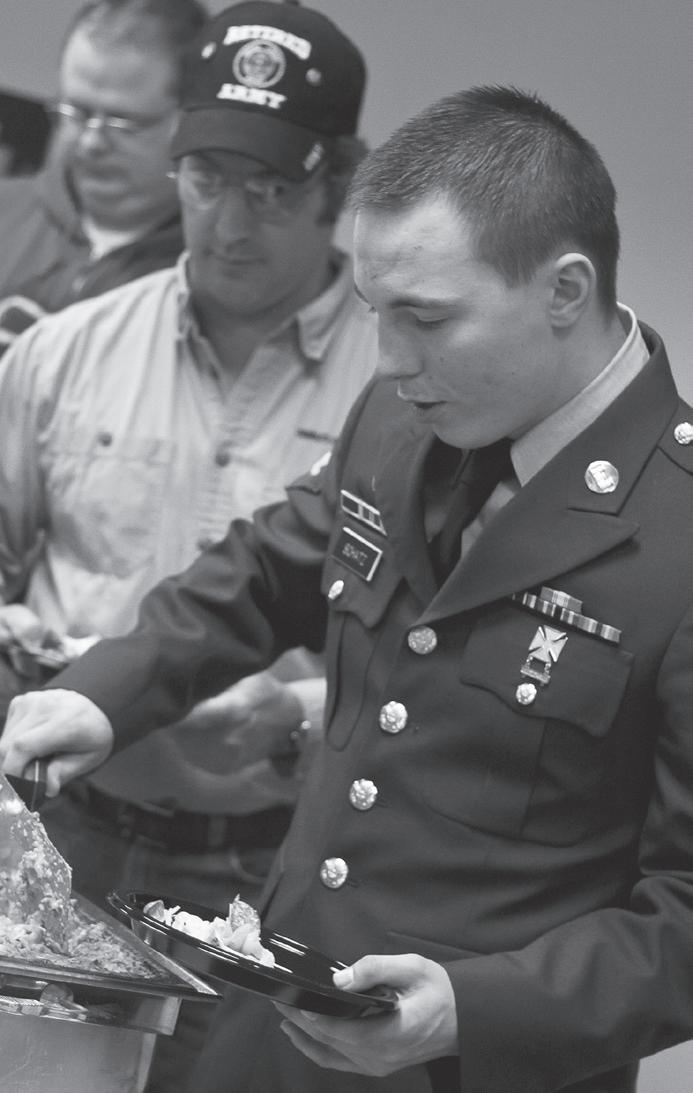
Better than MRE’s. Gabe Green/Sentinel
were viciously attacking Pearl Harbor, Peluso was struggling to survive and protect his base. “We looked straight ahead of us, and there was a big ball of fire. It was the USS Saratoga got hit by a suicide plane,” Peluso said, The Spokesman Review. The USS Saratoga was hit by five more suicide planes and by some miracle, stayed into a wheel borrow and helped build rock dams in order to slow the water down so the trail wouldn’t get washed out. “What fun! It’s hilarious. These kids are gung-ho!” said Tiffany Heiss, 36, a volunteer for BLM and the attendant at the rock loading section. According to Chivvis, more than 650 feet of new trail was built. “My favorite part is the pelts! I got to touch the skunk!” said Sieryn Johnson, 8, Sorenson. Carrie Hugo, awildlife biologist for the BLM taught the kids about animal tracks and “POI” (poop of interest) then took them on a short hike to identify signs of wildlife. She read many Nez Perce legends, searching for the one she could “tell from the heart.” Her creation story turned out to be the tale of Coyote and the Kamiah Monster, Paul said. Coyote, a trickster who also acted benevolently, was the greatest of the animal people. In the story, Coyote slays a monster that has eaten the other animal, thereby rescuing them. Coyote then uses the monster’s body parts to create the different Indian tribes, imbuing these tribes with certain traits. According to the story, Coyote created the Nez Perce from the monster’s heart, declaring that the Nez Perce would be strong, brave and intelligent. afloat. Another of the kamikaze planes began to head for the USS Bismarck Sea that Peluso was aboard. “I seen one going by and I could see he had a white headband around his forehead. He was about five feet above the water and we couldn’t angle our guns down that far, Peluso said, The Spokesman Review. “He was coming in low and off at an angle…just about even with us.” Each year on Veterans Day a national ceremony is held in Arlington National Ceremony. The men and women that fell in battle and were not identified are honored by the laying of a wreath at the Tomb of the Unknowns. “To us in America, the reflections of Armistice Day will be filled with solemn pride in the heroism of those who died in the country’s service and with gratitude for the victory, both because of the thing from which it has freed us and because of the opportunity it has given America to show her sympathy with peace and justice in the councils of the nations…” said President Wilson addressing the beginning of Armistice Day, 1919. Armistice Day was approved by Congress as a legal holiday May 13th 1938 and later, after World War II, Armistice was crossed out and replaced with “Veterans” to honor men and women of all wars in June of 1954. “To me a Veteran is someone that served their country, whether they lived or died, they served their country. They blazed the trail for us to follow,” said Second
Third graders learn basics of trail building NIC students assist younger generation in the wilderness
Kennedy, 8, and Rebecca Kemner make dams on the trail. Ethan Schlussler/Sentinel
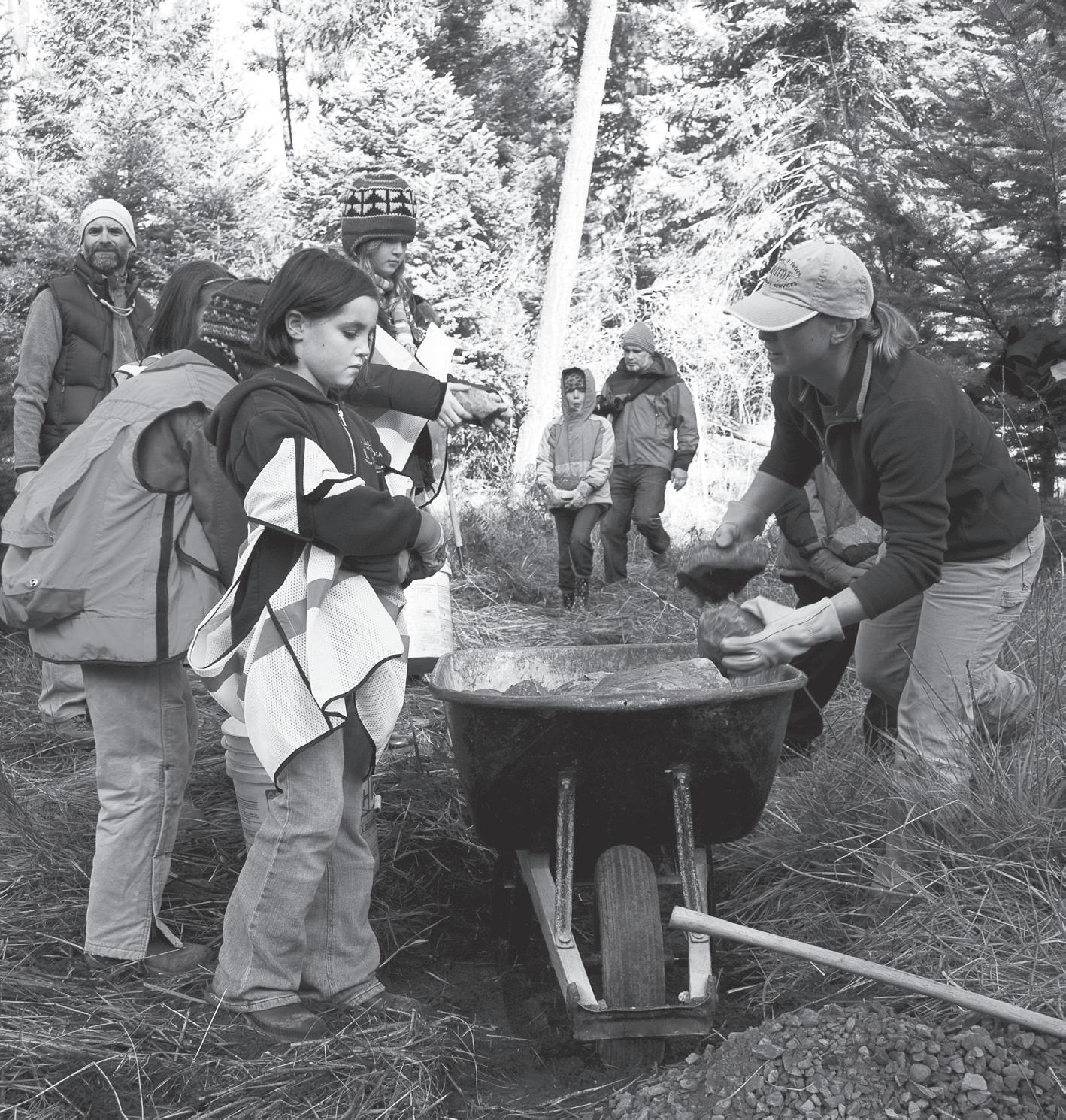
Lieutenant Robert Lind, Army Reserves. “I liked the nature wildlife section, learning about how they [animals] die and stuff,” said Adam Fortin, 8, Sorenson. “The big beaver and the porcupine was the most interesting because it shoots its quills at its prey.“ “I believe hands on experiences gives a better understanding of principles and practices that we discuss during lecture,” said Chivvis. “In addition, students get to see results for their labor and cooperation with other organizations.” “This is a great place. It’s tucked away,” said Suzanne Endlsey BLM public affairs specialist. “We are cleaning it up and families like to come here now. Now these kids
can come back here with their families.” Intelligent. That word rang in Paul’s mind, she said, giving her confidence—and when she went back to school, her GPA shot from 2.0 to 3.8 in one semester. “When we listen to each other, we understand each other,” Paul said. “Our stories are worth dying for. Are we ready to hear our stories?” Paul said that the first step in the healing journey is to go where the wound occurred, tell the story, begin to forgive, and let go. “It is time for us to heal,” Paul said, “but it is also time for us to listen to each other. When we hear each other’s stories, we have a chance to heal as humanity.”
Air travel is a miserable experience
If nature intended man to fl y, he’d have wings
Michael Paquin


Lifestyles Editor
We’re experiencing mild turbulence. Probably because the right aileron has dislodged from the wing and is plummeting end over end to the ground. Any second now the plane will do like-wise. And as we plunge toward the earth in an uncontrolled nosedive at terminal velocity, I hope the captain at least has the decency to spare us the “please fasten your useless seat belt” speech To say I have a fear of flying would be underselling it. Walking down the track to the cabin of the plane (my own personal valley of the shadow of death), I can’t help but feel claustrophobic, dragging my dopey looking luggage bag with the wheels that are far to small to keep it’s locomotion fluent and stable. But getting on the plane and finding my seat (always the middle one, of course) is truly when I begin to lose it. The beginning of the end, so to speak. At takeoff I’m white-knuckling it. The only thing I have to look forward to once we’ve reached cruising altitude is receiving permission from the crew to recline my seat back a whole five degrees. I really do consider every flight I’ve ever taken a near-death experience. Everyone has a story about the time they almost
“...I hope the died or found captain at least has the themselves in a situation that was beyond decency to spare us the words, and categorizing a plane experi
‘please fasten ence as one of your useless seatbelts’ these wouldn’t be that far fetched, in my speech.” opinion. Think about it. Let’s say someone tells you about close call involving a white water rafting accident or something. Well, here would be my follow up: One time I was suspended thirty-five thousand feet in the air and going 450 mph over a distance spanning the greater North American continent. Of course then they’ll say, “So what’s the big deal? You were in a plane.” A plane? You mean that 30-yearold machine with millions of miles on it that’s maintained by a company that’s now too cheap to hand out free peanuts? And I can’t tell you how many times I’ve been told that statistically speaking, it’s safer than driving. Statistically speaking, I don’t give a damn. If a component in your car malfunctions, you pull over and fix it, or if you’re like me, call a tow-truck. But if one of the thousands of incredibly delicate instruments that are crucial to the success of a flight malfunction, the integrity of the entire plane is compromised. I’ve been told of the numerous fail-safes the industry has to keep everyone (by everyone I mean the government) happy, but you still see air disasters in the news. My only solace once trapped in the aerial tube of natural law defying technology is the catalogue in the seat in front of me. Typically, they’re packed full of items so trivial they couldn’t even make it into a Sharper Image catalogue. Oh, and look at that, you can even subscribe to it so you can receive monthly issues at your house like an idiot. I understand that crippling phobias aside, most people still find the experience of flying unpleasant. Airline companies haven’t been doing their fair share of pandering to the consumer in the past fifteen or twenty years, mostly because they realize people will always need to fly for one reason or another, but I for one am hopefully looking toward the future. It’s too bad I’ll probably never live to see the teleportation device.


